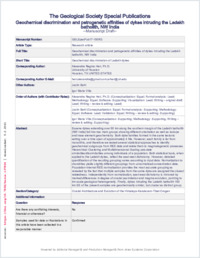Geochemical discrimination and petrogenetic affinities of dykes intruding the Ladakh batholith, NW India
- Heri, A. R. Department of Earth Sciences, University of Hong Kong, Pokfulam Road, Hong Kong, China
- Bahl, J. ORCID Department of Epidemiology, Health Science Center at Houston, University of Texas, 1200 Pressler Street, Houston, TX 77030, USA
- Villa, I. M. ORCID Institut für Geologie, Universität Bern, Baltzerstrasse 1, 3012 Bern, Switzerland
- 2019-4-12
Published in:
- Geological Society, London, Special Publications. - Geological Society of London. - 2019, vol. 481, no. 1, p. 231-250
English
Abstract Eocene dykes extending over 50 km along the southern margin of the Ladakh batholith (NW India) fall into two main groups showing different orientations, as well as different isotope and trace element geochemistry. Both dyke families formed in the same tectonic setting over a time span of approximately 4 Ma. However, each family is far from monolithic, and therefore we tested several statistical approaches to identify geochemical subgroups from rare earth element (REE) data and relate them to magmatogenetic processes. Hierarchical clustering and multidimensional scaling calculate similarities/dissimilarities among individuals of a population. Both statistical tools, when applied to the Ladakh dykes, reflect the east–west dichotomy. However, detailed quantification of the resulting grouping varies according to input data. Normalization to chondrites yields slightly different groupings from unnormalized concentration data. Population internal REE normalization provides the most accurate grouping, as revealed by the fact that multiple samples from the same dyke are assigned the closest relatedness. Independently from normalization, east–west dichotomy is mirrored by marked differences in the degree of crustal assimilation and magma evolution, pointing to kilometre-scale geological heterogeneity. Finally, dykes intruding the Ladakh batholith 150 km SE of the present samples are geochemically similar, but cluster as a distinct group.
- Language
-
- English
- Open access status
- green
- Identifiers
-
- DOI 10.1144/sp481-2017-150
- ISSN 0305-8719
- Persistent URL
- https://folia.unifr.ch/global/documents/14819
Statistics
Document views: 17
File downloads:
- fulltext.pdf: 0
